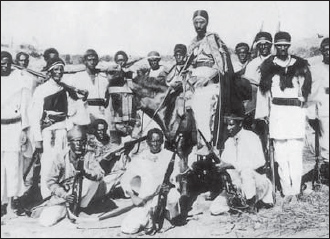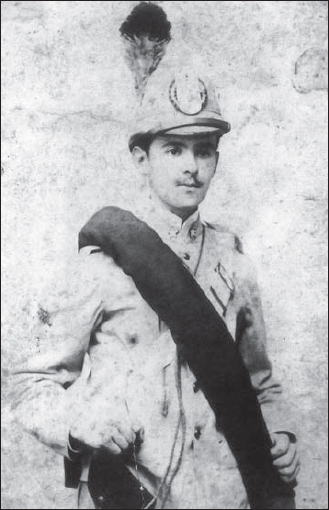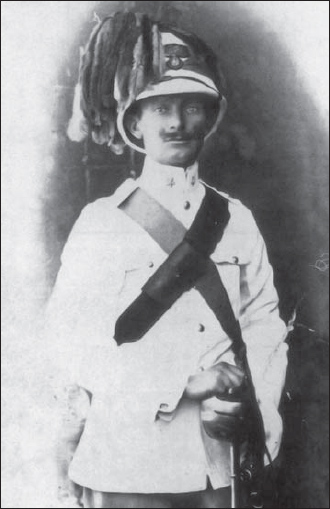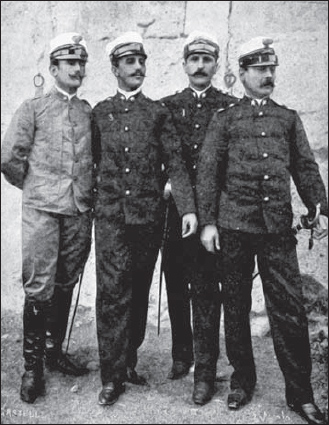
A: ETHIOPIAN LEADERS
The ‘king of kings’ wears a lion’s-mane headdress – a traditional symbol of aristocracy – and a gold-embroidered crimson velvet cape over a striped silk tunic and white trousers; note that he also wears European-style ankle boots. He is armed with a Lebel M1886 repeating rifle, and carries a conical shield (tafa, or gasha) of sheet iron covered with velvet and tin, silver, copper and gold embellishments. Menelik’s horse-harness also has lavish gold decorations. (From the well-known portrait by Paul Buffet, painted at Addis Ababa a few months after Adowa, and now in the Musée d’Orsay, Paris.)
Menelik’s cousin was governor of Harar province, and a general at Adowa. He wears a richly gold-embroidered navy-blue garment falling several inches below the knee, and slit deeply up the sides for ease when riding. Around his neck hangs an ornate silver cross in the Ethiopian style. Wrapped diagonally across his chest is a decorated cape of soft hide with hanging extensions, which is fastened at his left shoulder by a massive rectangular brooch. The cape’s hanging extensions are gathered by the brooch and under a cartridge belt with rifle rounds, and a second belt supports the curved sheath of a traditional shotel sword. The shield is a simpler hunting type, of buffalo, hippopotamus or rhinocerous hide. (From the photo portrait by Luigi Naretti.)
B: ETHIOPIAN TROOPS
B1: Infantry swordsman
While some 80 per cent of the Ethiopian troops in 1896 had rifles, a minority carried only traditional equipment, like this warrior’s curved shotel (shown drawn in 1a), and relatively simple hide shield. His plain white shamma, typical of many Ethiopian peoples, is draped around his shoulders, over a long white kammish shirt-tunic slit up the sides, and trousers. Ethiopian warriors rarely wore footwear, since they were accustomed to walking barefoot over rough terrain.
B2: Infantry officer, Tigré
The lionskin headdress and cape show him to be a brave hunter, since only those who had killed a lion were allowed to wear them. (However, lesser men often wore headdresses made of the fur of a baboon – gelada.) The cape or lembd – whose appearance has been compared by some commentators to an Orthodox churchman’s dalmatic – is the sign of his status as a member of the highest warrior caste; note that it incorporates at the front two wide hanging extensions of decorated leather. His primary weapon would probably be a Vetterli M1870 rifle, a reminder of friendlier times before Italy stopped arms shipments.
B3: Amhara rifleman, Shewa
The central Ethiopian kingdom of Shewa was made up of Oromo and Amhara; the people of the latter were mostly Christian, and this warrior too would wear an Ethiopian-style silver cross at his throat. He wears a simpler velvet lembd over his plain white shamma, with the hanging front extensions gathered under a sash and his sword belt, and a small white turban. His weapon is a Mauser M1871 rifle. The Ethiopians generally did not use bayonets, since they were already skilled with equally effective hand-to-hand weapons.

A group of warriors from Eritrea in Italian service, 1896; a number of such elements were present with Baratieri’s army at Adowa. There is little to distinguish them from Menelik’s warriors, except perhaps for a higher proportion of modern rifles. The man standing tallest appears to be the leader, to judge from his fine robe; note his ammunition belt (see A2), and also the lionskin cape worn by the man on the right. (Courtesy SME/US)
C: SUDANESE MAHDIST WARRIORS
C1: Baqqara cavalryman
This warrior is protected by quilted armour under an iron helmet and long ringmail shirt; note too the extensive quilted horse-armour and leather chamfron. He is armed with a spear with a broad leaf-shaped head, and a kaskara sword and flintlock pistol carried on his saddle. The Dervishes plundered many Martini-Henry rifles from defeated Egyptian soldiers, but the only modern touch to disrupt the splendidly medieval impression created by this warrior is a holstered revolver at his hip.
C2: Sudanese footsoldier
This infantryman, too, wears quilted armour; while useless against firearms, this was still fairly effective against the spears and swords of the Mahdists’ tribal enemies. He is armed with a spear, and a kaskara sword carried in a crocodile-skin scabbard; the flared end of the scabbard is purely stylistic, as the blade has conventional parallel edges. His concave hide shield with a large boss and nicked rim is of a type common in the Sudan.
D: ITALIAN INFANTRY, 1895–96
D1 & 2: Private, Cacciatori d’Africa, marching order
The first of these light infantry units was raised in 1887 specifically for service in Africa, but although a battalion served with the Eritrea garrison they did not take part in the advance to Adowa in 1896. They were distinguished by a tall green feather panache, rising from a pompon bearing the battalion number, on the right side of the M1887 cork helmet; this did not have a chinstrap for foot troops. Helmet badges identified the branch of service, set on a large cockade in the red, white and green of the Italian national tricolour. Apart from these branch distinctions, this soldier wears the standard Italian infantry uniform and equipment seen at Adowa. The new service jacket and trousers, authorized in 1887 but officially ordered only in February 1889, are of linen in a pale khaki shade called in Italian ‘light bronze’; note that a matching cloth helmet cover was also sometimes issued. The tunic had five front buttons, shoulder straps, and two pleats down the front that gave it something of the look of a ‘Norfolk jacket’ (see H1); there were slight alterations to the cut in 1892 and 1893. The standing collar bore the national star of Savoy for all branches, in white cloth for rankers – here the collar is opened and folded down, hiding the badge. The regulation boots are almost covered here by light cloth spat-type gaiters to protect them from the dust and thorns.
On the eve of the Adowa campaign Gen Baratieri ordered that all his infantry be issued the M1874/81 dark blue cape of the Bersaglieri and Alpini, carried here in a horseshoe roll. The belt has two large ammunition pouches, also supported by a strap round the neck. He has an old-fashioned M1876 iron-strapped wooden water canteen, and his haversack of blue-and-white ticking material for spare underclothes and small kit dates back to the Piedmontese army (off-white haversacks were also used). The white metal lidded messtin was sometimes carried fastened to the back of the belt, containing immediate-use rations. His weapon is the old 10.4mm M1870/87 Vetterli; the new 6.5mm M1891 Mannlicher-Carcano rifle was not issued in Eritrea until summer 1896, after the Adowa campaign.

This portrait of Alfredo Gaddi, an enlisted man of the Carabinieri, was taken in 1896, and offers a reasonable view of the standard khaki uniform of 1887 pattern, worn with a cork helmet complete with the badge and parade plume of this corps. All Italian troops were issued with the dark blue cape of the Bersaglieri, and wore it in a horseshoe roll when in the field. The national stars on the standing jacket collar are of white linen. (Courtesy SME/US)
D3: Corporal, Fanteria d’Africa, marching order
Most of the soldiers newly arrived in the last few months before Adowa had not received the full field kit, but rather a variety of items haphazardly issued or obtained. This corporal – note the red rank insignia, worn on both forearms – has a wide-brimmed M1887 straw hat, modelled on the seaman’s hat that some officers and troops of the Corpo Speciale d’Africa had acquired for use since 1885. This soldier has been on the march for several days; his uniform is ragged, and his boots are showing signs of wear. He carries an M1868 Remington ‘rolling-block’ rifle from the armouries of the Papal States (perhaps even picked up locally, since most of these were sold to Menelik in 1883–88).
E: CAVALRY
E1: Ethiopian Oromo horseman
These elite Ethiopian cavalry played an effective part in the harassing and pursuit of the broken Italian army after Adowa. He wears a goatskin cape over a simple shamma robe and white trousers; note the ‘big toe’ style of using the stirrups. His horse harness is colourfully decorated even though he is plainly dressed and equipped – with several spears and javelins, and a simple shield with an upturned rim for catching spear-points. Additional typical weapons were a shotel and/or a large knife, and there are mentions of riders at Adowa firing pistols. Some period photos show Ethiopians with revolvers. Like their rifles, these would have been of a variety of makes; relatively few would have been used in battle, where a rifle was much more useful. The tough local horses and ponies were favoured for their ability to endure the punishing terrain and conditions of the highlands.
E2: Ascari, native cavalry ‘Penne di Falco’; Kassala, 1894
This Eritrean soldier’s red tarbush has no tassel; it is decorated with a hawk’s feather, a multi-coloured striped turban, and the Italian cavalry badge of an un-numbered unit – a crowned disc bearing the Savoy cross, set on crossed lances. He wears a white jacket and trousers with buttoned cloth leggings. The red sash identifies the 2nd (Keren) Squadron, raised in 1890, which fought the Mahdists at Second Agordat and Kassala; the 1st (Asmara) Sqn, which wore a yellow/red striped sash, was raised in 1889 and disbanded in 1894. He is armed with an M1870/87 Vetterli carbine with integral bayonet, its ammunition carried in a locally-made pouch-bandolier; an M1874 revolver, with a separate cartridge belt; an M1871 cavalry sabre; and a large native knife. When items of kit wore out, individuals often replaced them with local equivalents – even the sabre was sometimes replaced with a shotel. He would ride a full-sized European horse; since these were unsuited to work in the Ethiopian uplands, this small unit did not fight at Adowa.
F1: Artillery lieutenant, marching order
The small M1895 service cap – an item widely worn in the field – has a white crown, dark blue band, and black peak and chinstrap. It displays the gold-embroidered badge of his branch of service above two gold rank stripes, and at the base of the band a piping in branch-of-service colour – here, red. The officers’ version of the M1887 khaki jacket had additional internal pockets (note the buttons on the pleats). The insignia are silver national stars on the collar, and the lieutenant’s cuff ranking, of the same basic design as for NCOs but in blue. All officers of mounted branches wore a leather pouch belt over the left shoulder. The officers’ light blue sash over the right shoulder was worn in Italy with all orders of dress, and in Africa with full dress and marching order. His M1889 revolver is out of sight on his right hip; his sword is the M1864 artillery officer’s sabre.
F2: Beni Amer guide
This guide, from an Italian-allied tribe living in the borderlands of the Eritrea colony, wears a distinctive foot-long hairpin thrust into his ‘afro’. His buff-coloured garment is similar to a shamma; unlike many peoples of the Shewa heartland, he does not wear trousers underneath. He carries a broadsword and a large hide shield slung from his shoulder, and a curved knife in a leather sheath at his side.
F3: Captain, Fanteria d’Africa, marching order
Since he would be mounted, his cork helmet has a chinstrap. The blue helmet band began life as a manoeuvre marking worn by all ranks, but later became the distinguishing mark of officers, especially in the field; from 1894 it was incorporated on their helmets by manufacturers. His uniform is virtually the same as that worn by F1, but since officers’ clothing was privately tailored the exact shades of khaki often varied. Note the triple cuff ranking of a captain, and M1887 cloth leggings instead of riding boots. His sword is the M1888 officer’s sabre for all branches of the Corpo Speciale d’Africa; it should have had a leather and metal scabbard, but photos habitually show them carried in the metal scabbard of previous home-service weapons. His revolver, again, is obscured here, worn holstered on the right hip, butt forwards. Various types of 10.35mm six-shot revolver were in simultaneous use by Italian officers; at Adowa the most common was the M1889 Glisenti, made in several differing models by dispersed factories. Given the very short effective range of any revolver, handguns were not much used except when the Ethiopians made their final rushes. When the fighting got desperate, some officers picked up rifles from dead privates and joined the firing line.
F4: Captain, Cacciatori d’Africa, full dress
The new white M1894 cork helmet incorporates the officers’ blue band, and bears this branch’s badge and parade plume. The new M1894 special full dress uniform for Africa was in dark blue cotton, its five front buttons centred on ‘loops’ of black cord frogging. Ranking moved from the cuffs to the shoulder straps – one to three silver stars for company officers, one to three gold for field officers. This elegant, lightweight garment was very popular, and photos show it widely worn in the field as a ‘patrol jacket’, with khaki or white trousers. This officer wears the complete uniform for a parade, with white gloves, and the same M1888 sabre as F2. His medals are the cross of a Knight of the Order of the Crown of Italy, and the African campaign medal with four clasps.

Another posed studio portrait, showing Lt Mario Abba of the Carabinieri in parade dress, taken at Massawa in 1895. Note the blue sash worn from his right shoulder, under the bandolier; the officer’s blue helmet band is just visible behind the badge. (Courtesy SME/US)
G: ASCARI, 1895–96
G1: Habab irregular
This youth has accompanied the Italian march more or less as a camp follower, but in hopes of earning his name in battle. The Habab, also known as Beja, are semi-nomadic Muslims from the southern Sudan between the Nile and the Red Sea, and tribesmen volunteered for both sides during the Adowa campaign. Here the shamma is wrapped around the waist, leaving his chest bare and his right arm free. He carries a simple spear about 5ft long with a heavy, lozenge-shaped head, and his hippopotamus-hide shield is a slightly concave oval with a central boss. He also carries a camel-driver’s sabre-shaped wooden stick.
G2: Ascaro, 2nd Eritrean Battalion ‘Hidalgo’
The official term for a native infantryman was a zaptiè, but in practice ascaro was used for all African troops. The Native Battalions were known by the names of their commanders, and identified by the colour of the long, deep woollen etaga sash, and/or the tassel on the tarbush: 1st (Turitto) Bn, red; 2nd (Hidalgo), light blue; 3rd (Galliano), crimson; 4th (Toselli), black; 5th (Ameglio), ‘tartan’; 6th (Cossu), green, later red/black; 7th (Valli), white, later red/light blue; 8th (Gamerra), russet. Here no sash is worn, but the tarbush has the light blue tassel. Sometimes a white headcloth was worn beneath the tarbush, and could be folded up around it. The clothing and equipment of native troops varied to some extent; this soldier has only a shamma around his shoulders, over the usual calf-length white senafilo trousers. The ammunition for his M1870/87 Vetterli-Vitalli ‘special troops’ rifle is carried in a simple waist bandolier.
G3: Sciumbasi, 6th Eritrean Battalion ‘Cossu’
This senior NCO serves with one of Gen Albertone’s ill-fated units, identified by his green sash and cap tassel. His rank, equivalent to a sergeant-major, is shown by the three silver stars on the tarbush, and the three red chevrons on both sleeves. Two stars and two chevrons, and one star and one chevron, were displayed by a buluk-basci (sergeant) and muntaz (corporal) respectively; the ascaro (private) had no rank insignia. On the march, this soldier has the dark blue Bersaglieri cape slung in a horseshoe roll, and behind his right and left hips respectively a leather waterskin and a haversack. Ammunition for his old single-shot M1870 Vetterli is carried in a single belly box, and a second belt supports the shotel that he carries for close work instead of a bayonet.
H: ITALIAN OFFICERS & NCO, 1895–96
H1: Sergeant-major, Fanteria d’Africa, marching order
In place of the cork helmet, this furiere – his rank identified by the two narrow and one wide red braids on his cuffs – chooses to wear the M1885/87 enlisted ranks’ service cap. This dark blue cotton colonial version of the M1872/82 headgear has a cloth badge in the form of a red star piped white, bearing his original regimental number in white in a black circle. He wears the M1887 khaki jacket, with the M1887 white trousers specified for men serving with native troops, bloused into his ankle boots. His weapons are an old M1874 revolver and an M1833 infantry senior NCO’s sabre, carried at his hips from a belt worn under the jacket. His field kit is the Bersaglieri cape, over a slung canteen.
H2: Infantry captain, Truppe d’Africa, service dress
Officers and men allocated to the cadres of native units continued to display the number of their parent regiment – here, a silver-embroidered crowned ‘93’. The M1887 service cap is very similar to the M1895 (see F1); but it bears two silver rank stripes, between two dark red branch-of-service stripes. The white uniform prescribed in 1887 for officers and men destined to serve with native troops has slightly different cuff ranking in chevron form, and shows clearly the officers’ pocket details of the 1887 regulations. He carries a curbash local horse-whip.

Four artillery officers in 1896, one wearing M1887 khakis and three the dark blue M1894 colonial full dress uniform, all with white-topped service caps; compare with Plates F and H. They are named as Castelli, Saya, Capt Masotto and Capt Bianchini. All four died at Adowa, the last two while commanding the 3rd and 4th ‘Sicilian’ Mountain Batteries with Albertone’s Native Brigade. (Piero Crociani Collection)
H3: Lieutenant, Bersaglieri, marching order
Two battalions of Bersaglieri distinguished themselves at Adowa while serving with Gen Arimondi’s brigade. This company officer wears the new white M1894 helmet complete with the officers’ blue band and the badge and plumes of his branch. The M1887 khaki uniform is the same as that worn by F1 and F3, but with the trousers loose over ankle boots. Officers of this branch always retained the M1850 Bersaglieri officer’s sabre.